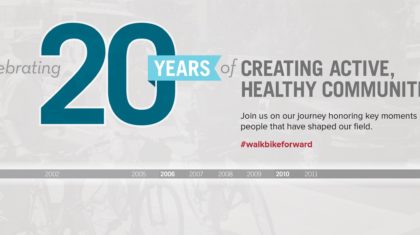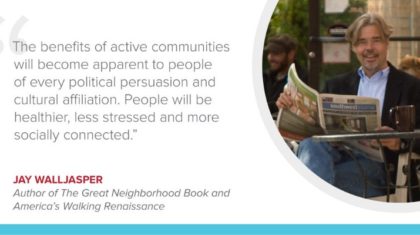#WalkBikeForward: Join us on our journey honoring key moments and people that have shaped our field as we celebrate 20 years of creating active, healthy communities.

Jay Walljasper — author of The Great Neighborhood Book and America’s Walking Renaissance — writes, consults and speaks about how to create healthier, happier communities. An Urban-Writer-in-Residence at Augsburg College in Minneapolis and a Senior Fellow at Project for Public Spaces, he was editor of Utne Reader magazine for 15 years.
Active Transportation is Patriotic
Growing up in college towns, I naturally assumed that walking, biking and comfortable public spaces were important to any self-respecting community. It was a shock to find that so many places across the country were almost uninhabitable if you did not want to drive everywhere all the time.
A breakthrough for me was traveling to Europe, where I discovered that walking, biking, transit and great public spaces were a way of life in most towns. I would come home from reporting stories abroad and feel depressed about the auto-cratic realities of American life. Many other folks felt the same way, I discovered, and this became the nucleus of the Active Transportation movement. A certain patriotic spirit began to stir coast-to-coast. Americans are an enterprising, inventive people, so there is no reason we can’t create cities that are as pleasurable as Copenhagen or Bologna or Melbourne or Curitiba, Brazil. That’s beginning to happen now, and Alta’s played a key role.
Everyday people in cities, suburbs and small towns — who once idly accepted motor vehicles domineering their hometowns — now clamor for better places to walk, ride their bikes, take their kids or just hang out with neighbors or friends.
A healthier, happier tomorrow
I’m optimistic that biking and walking will come to be seen as an organic part of folks’ daily lives in the coming decades. The daily stroll will become as common as a coffee break. Most kids will trot or pedal to school. Many of your co-workers will commute 5–10–20 miles on bike. The Millennial generation will continue to insist on a choice of mobility options as they settle down and raise families — the autonomous car being just one of many.
This will have a dramatic effect on our communities. Many residential streets will become pedestrian lanes, where pavement is replaced with picnic tables, playgrounds and vegetable gardens. Our neighborhoods will become 21st Century villages, where most of your needs for goods, services, recreation, entertainment and socializing will be within easy walking distance. This will happen in low-income areas as well as wealthy ones; in suburbs and small towns as well as big cities.
The benefits of active communities will become apparent to people of every political persuasion and cultural affiliation. People will be healthier, less stressed and more socially connected. Neighborhoods will be livelier, safer and less polluted. This will result in an epidemic of smiles, noticeable on people as you pass them on the street.


